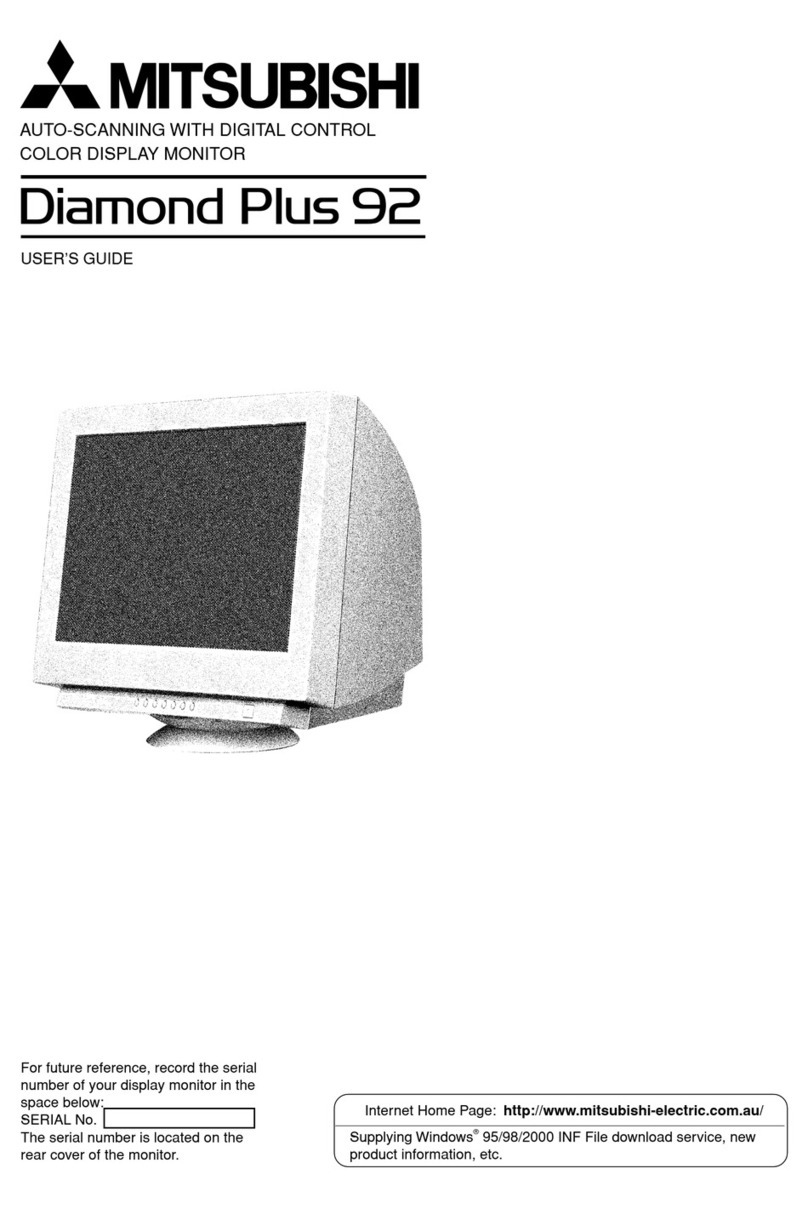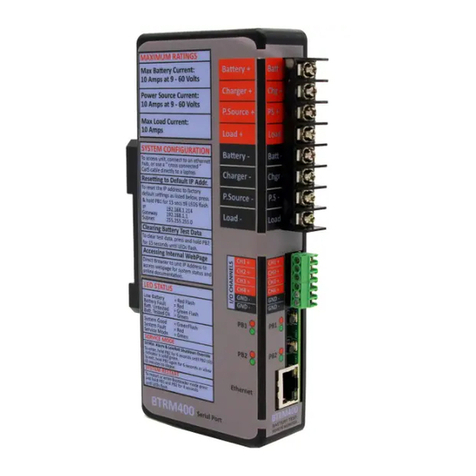Genesis Automation moTrona DZ 210 User manual

control – motion – interface
DZ 210
Monitor for Direction of Rotation and Standstill
Simple and compact unit to monitor forward motion,
reverse motion and zero motion
Universal impulse inputs for use with all common incremental
encoders and sensors (HTL, RS422 or TTL)
Two output relays (dry change-over contacts) as well as
two fast-responding power transistor outputs
Wide input frequency range (up to 500 kHz) and
fast response time (<1 msec. with f >1 kHz)
Operating Instructions
3046 Home Road. Powell, OH 43065 P: (740) 917-5781 F: (740) 917-5791 www.GenesisAutomationOnline.com [email protected]

Safety Instructions
This manual is an essential part of the unit and contains important hints about
function, correct handling and commissioning. Non-observance can result in
damage to the unit or the machine or even in injury to persons using the
equipment!
The unit must only be installed, connected and activated by a qualified electrician
It is a must to observe all general and also all country-specific and application-
specific safety standards
When this unit is used with applications where failure or maloperation could cause
damage to a machine or hazard to the operating staff, it is indispensable to meet
effective precautions in order to avoid such consequences
Regarding installation, wiring, environmental conditions, screening of cables and
earthing, you must follow the general standards of industrial automation industry
- Errors and omissions excepted –
Version:
Description:
DZ21001a/af/hk_Au
g
2007
First edition
DZ21001b/tj/nw_
F
eb
201
4
Correction in chapter 2.3. Impulse Inputs
3046 Home Road. Powell, OH 43065 P: (740) 917-5781 F: (740) 917-5791 www.GenesisAutomationOnline.com [email protected]

Table of Contents
1. Introduction ................................................................................................. 4
2. Connections and Terminal Assignments ...................................................... 4
2.1. Power Supply.........................................................................................................5
2.2. Auxiliary Power output..........................................................................................5
2.3. Impulse Inputs .......................................................................................................5
2.4. Reset Input ............................................................................................................5
2.5. Relay Outputs ........................................................................................................5
2.6. Transistor Outputs.................................................................................................6
2.7. The Front LEDs.......................................................................................................6
3. Switch Settings ........................................................................................... 6
3.1. Setup of the Impulse Inputs ..................................................................................6
3.2. Basic Switching Functions ....................................................................................7
3.3. Setting of the Standstill Time (T) ..........................................................................8
3.4. Definition of Direction of Rotation........................................................................9
4. Technical Specifications ............................................................................ 11
5. Dimensions................................................................................................ 12
3046 Home Road. Powell, OH 43065 P: (740) 917-5781 F: (740) 917-5791 www.GenesisAutomationOnline.com [email protected]

1. Introduction
DZ210 has been designed as a monitor module for assembly in electrical control cabinets.
The units are suitable for monitoring the direction of rotation and the zero-motion state with
industrial machine applications.
As remarkable properties, the DZ 210 units provide a very high input frequency range, a very
fast response time and versatile settings for encoder characteristics and evaluation of the
signals with respect to direction and standstill detection.
2. Connections and Terminal Assignments
The units provide a 9-position screw terminal strip on the bottom side for power supply and
input signals, and three 3-position terminals on the top, for the outputs. The drawing below
explains the function and assignment of the screw terminal strips.
LED
DIL 1 DIL 2
NO
NC
C
NO
NC
C
X1 (
Rel 1)
X2
(Rel 2)
X3
(digital)
C+
Out 1
Out 2
9
8
1
2
3
4
5
6
7
G
N
D
D
C
i
n
A
/
A
B
/
B
R
e
s
.
+
5
.
4
o
u
t
G
N
D
X4
1
7
-
3
0
V
+
5
V
o
u
t
+
R
e
s
e
t
3046 Home Road. Powell, OH 43065 P: (740) 917-5781 F: (740) 917-5791 www.GenesisAutomationOnline.com [email protected]

2.1. Power Supply
The unit operates with a DC power from 17 to 30 V, applied to terminals 1 and 2 of terminal
strip X4. The power consumption is approx. 30 mA (plus about 30% of the current taken from
the auxiliary 5 V output)
2.2. Auxiliary Power output
Positions 8 and 9 of terminal strip X4 provide an auxiliary, stabilized 5 VDC output. The real
output voltage is a little higher (e.g. 5.4 V) in order to compensate for voltage drop on
connectors and cables. The auxiliary output is intended for supply of encoders and sensors. The
output current must not exceed 200 mA.
2.3. Impulse Inputs
The unit features the input channels A, /A (A inverted), B and /B (B inverted). For detection the
direction of rotation it is mandatory to apply at least signals A and B, with a distinguishable
phase displacement (in general 90°). Inverted signals /A and /B are only needed with
differential TTL inputs or RS422 input signals.
The inputs can be set by DIL switch to any of the following characteristics:
Impulse formats:
HTL level 10 - 30 V
TTL level (differential) respectively RS422 format (inverted signals included)
TTL level single-ended (without inverted signals)
Switching characteristics:
PNP (switching to +)
NPN (switching to -)
Tristate (Impedance 10 k)
2.4. Reset Input
A Reset input provides shutdown of all internal functions and forces the unit to "standstill"
state. The switching characteristic of the Reset input is always HTL / PNP, i.e. you have to
apply a positive signal (10 to 30 V) to effectuate the Reset state.
2.5. Relay Outputs
There are two output relays available (dry change-over contacts) with a switching capability of
30 VDC / 2 A respectively 230 VAC / 0.3 A. The response time of the relays is in a range of 5
msec.
Relay 1 (terminal X1) is always used to indicate the direction of rotation, according to the actual
A / B phase situation. Relay 2 (terminal X2) can be set by DIL switch to either indicate the other
direction of rotation, or to monitor "standstill"
3046 Home Road. Powell, OH 43065 P: (740) 917-5781 F: (740) 917-5791 www.GenesisAutomationOnline.com [email protected]

2.6. Transistor Outputs
Both transistor outputs "Out1" und "Out2" (terminal X3) operate in parallel to the relay
functions, but respond much faster (200 µsec only) than the relays.
The outputs are rated to switch DC voltage from 7 - 30 V at maximum currents of
350 mA (each).
The transistor outputs are 100% short-circuit-proof, however not both outputs must be short-
circuited at the same time for a longer duration.
2.7. The Front LEDs
The green LED on the front side of the unit signals that the unit is ready for operation. The
yellow LED signals the input frequency, i.e. it will blink or be lit while the unit detects rotation,
and it will be off when the unit detects standstill.
3. Switch Settings
3.1. Setup of the Impulse Inputs
Positions 1 to 5 of switch DIL 1 are used to set levels and switching characteristics of the
impulse inputs. Most of all practical applications would require one of the following three
standard settings:
Input Signal
Setting
DIL
1
RS422 or TTL symmetric
(differential signals A, /A, B und /B)
ON
ONOFF
HTL signal, asymmetric, PNP (switch to +)
(channels A and B only, no inverted signals)
ON
ONOFF
HTL signal, asymmetric, NPN (switch to -)
(channels A and B only, no inverted signals)
This setting is also suitable for NAMUR sensors
(2-wire). Observe special hint below.
ON
ONOFF
TTL signal asymmetric (single-ended)
(only A und B, no inverted signals)
ON
ONOFF
3046 Home Road. Powell, OH 43065 P: (740) 917-5781 F: (740) 917-5791 www.GenesisAutomationOnline.com [email protected]

More combinations can be set with consideration of the individual function of each switch
position, according to the following table:
1 OFF: HTL level (all of the 4 input lines) ON: TTL level (all of the 4 input lines)
2 OFF: Input B is symmetric (needs /B) ON: Input B is asymmetric (single-ended, no /B)
3 OFF: Input A is symmetric (needs /A) ON: Input A is asymmetric (single-ended, no /A)
4--- ON: internal pull-up resistor towards + *)
5--- ON: internal pull-down resistor towards GND *)
*) Positions 4 and 5 both ON = Tristate, input impedance = 10 kOhms
At any time one of the positions 4 and 5 must be "ON".
With 4 and 5 both OFF, the unit may produce undefined operations
Unused inputs should always be set to HTL level
With use of Namur (2-wire) sensors, please connect the positive wire to the
corresponding input, and the negative wire to GND.
With setting HTL and NPN all impulse inputs are tied to the positive potential
of the power supply (+24 V) via internal pull-up resistors. To avoid damage
with use of TTL encoders, it is advisable to first set the unit to TTL level prior
to connection of the encoder to the unit.
3.2. Basic Switching Functions
Positions 6, 7 and 8 of switch DIL1 allow selecting the following functions:
DIL 1 DIL 1
6 OFF: Standstill detection without post-trigger
function (see clarification below)
ON: Standstill detection with post-trigger function
(see clarification below)
7 OFF: Relay 2 and Out 2 to signal the opposite
direction of the Rel1/Out1 indication
ON: Relay 2 and Out 2 to signal zero motion
(standstill)
8 OFF: Upon detection of standstill, the
direction signal is cleared (no indication)
ON: Upon detection of standstill, the information of
the last actual direction remains active
The subsequent drawing explains the difference between "post trigger function on" and
"post trigger function off". In order to get a standstill signal at all, the time distance between
two positive edges must become greater than the setting "T".
Case (1) shows the post-trigger on.
The standstill signal immediately switches off again when another active edge is detected (no
matter after which time). In this case, during slow-down of the machine, the output and the
relay might therefore produce multiple on-off cycles before the standstill signal becomes
stationary. However this method could be considered as "more safe", because it would detect
any motion, no matter how slow it is.
Case (2) shows the post-trigger off.
After the standstill signal has switched on, it will remain on and only switch off again after two
subsequent edges have been detected where the time distance was less than T.
3046 Home Road. Powell, OH 43065 P: (740) 917-5781 F: (740) 917-5791 www.GenesisAutomationOnline.com Sales@GenesisAutomationOnline.com
3046 Home Road. Powell, OH 43065 P: (740) 917-5781 F: (740) 917-5791 www.GenesisAutomationOnline.com [email protected]

T
T
(1)
(2)
= Standstill signal OFF = Standstill signal ON
3.3. Setting of the Standstill Time (T)
Provided that the standstill function has been assigned to relay 2 and output 2 by setting DIL
switch 1 position 7 to ON, a standstill definition can be set by means of positions 1 - 4 of the
switch DIL 2. The table indicates the pause time between two input pulses that must be
exceeded in order to signal "standstill".
DIL 2
DIL 2
1 msec
ON
ONOFF
256 msec
ON
ONOFF
2 msec
ON
512 msec
ON
4 msec
ON
1.024 sec
ON
8 msec
ON
2.048 sec
ON
16 msec
ON
4.096 sec
ON
32 msec
ON
8.192 sec
ON
64 msec
ON
16.384 sec
ON
128 msec
ON
32.768 sec
ON
3046 Home Road. Powell, OH 43065 P: (740) 917-5781 F: (740) 917-5791 www.GenesisAutomationOnline.com Sales@GenesisAutomationOnline.com
3046 Home Road. Powell, OH 43065 P: (740) 917-5781 F: (740) 917-5791 www.GenesisAutomationOnline.com Sales@GenesisAutomationOnline.com
3046 Home Road. Powell, OH 43065 P: (740) 917-5781 F: (740) 917-5791 www.GenesisAutomationOnline.com [email protected]

3.4. Definition of Direction of Rotation
In order to achieve a stable indication of the actual direction of rotation even under vibration
and mechanical oscillation, positions 5 - 8 of switch DIL 2 provide setting of an impulse
window. Before detecting a direction or changing the direction signal, the unit must receive a
consecutive number of impulses in the corresponding direction. The table shows how to set the
switches to define the number of impulses required for detection of the direction.
DIL 2
DIL 2
1 Imp.
ON
ONOFF
9 Imp.
ON
ONOFF
2 Imp.
ON
10 Imp.
ON
3 Imp.
ON
11 Imp.
ON
4 Imp.
ON
12 Imp.
ON
5 Imp.
ON
13 Imp.
ON
6 Imp.
ON
14 Imp.
ON
7 Imp.
ON
15 Imp.
ON
8 Imp.
ON
16 Imp.
ON
3046 Home Road. Powell, OH 43065 P: (740) 917-5781 F: (740) 917-5791 www.GenesisAutomationOnline.com Sales@GenesisAutomationOnline.com
3046 Home Road. Powell, OH 43065 P: (740) 917-5781 F: (740) 917-5791 www.GenesisAutomationOnline.com [email protected]

The drawing below explains the operation of the direction outputs upon a change of direction.
With case (1) the window has been set to 1 impulse only. As a result the unit immediately
changes the output already after the very first impulse into the opposite direction.
With case (2) a window >1 has been set, wherewith the short change of the phase between
channels A and B does not affect the direction signal.
Channel A
= Forward motion = Reverse motion
(1)
(2)
Channel B
3046 Home Road. Powell, OH 43065 P: (740) 917-5781 F: (740) 917-5791 www.GenesisAutomationOnline.com [email protected]

4. Technical Specifications
Power supply
:
17
-
30 VDC
Current consumption
:
(Aux. output unloaded)
ca
. 30 mA
Auxiliary output
:
5.4 V, max. 200 mA
Maximum input frequency
:
500 kHz (RS422 and TTL
-
differential)
350 kHz (HTL and TTL single-ended)
Impulse inputs
:
A, /A, B, /B, versatile, for use with
RS422 signals
HTL signals (differential, single-ended, PNP, NPN)
TTL signals (differential, single-ended, PNP, NPN)
Input levels
:
RS422: voltage difference >=1 V
HTL: LOW < 4 V, HIGH > 9 V
TTL: LOW < 0,5 V, HIGH > 2,5 V
Input Impedance
:
NPN and PNP: 4.7 kOhms
Tristate: 10 kOhms
Relays
:
Dry change
-
over, switching delay approx. 5 msec.
Switching capability:
30 VDC/2 A or 125 VAC/0,6 A or 230 VAC/0,3 A
Transistor outputs
:
High
-
side driver, switching delay 200 µsec.
Switching voltage: 7 - 30 VDC
Switching current: max. 350 mA
100% short circuit proof
(not both outputs at a time for a long period)
Ambient temperature
:
Operation: 0°
-
45°
C (32°
-
113° F)
Storage: , -25° - +70° C (-13° - 158° F)
Weight
:
approx. 100 g
Conformity and standards
:
EMC
89/336/EEC:
EN 61000
-
6
-
2
EN 61000-6-3
3046 Home Road. Powell, OH 43065 P: (740) 917-5781 F: (740) 917-5791 www.GenesisAutomationOnline.com [email protected]

5. Dimensions
102 (4.016’’)
91 (3.583’’)
8
2
.
5
(
3
.
2
4
8
’
’
)
1
0
2
(
4
.
0
1
6
’
’
)
22.5
(0.886’’)
12345678
OFF ON
12345678
OFF ON
Side view
Top view
Front view
3046 Home Road. Powell, OH 43065 P: (740) 917-5781 F: (740) 917-5791 www.GenesisAutomationOnline.com [email protected]
Table of contents

